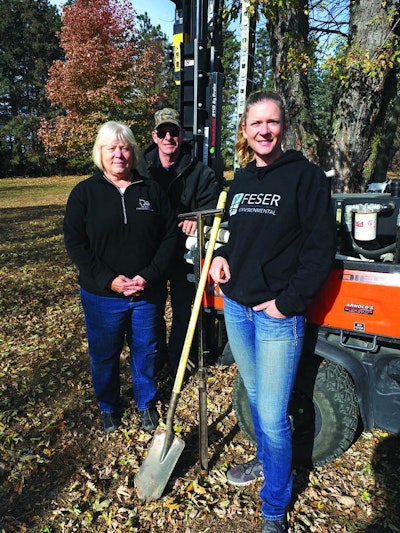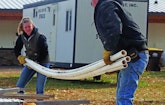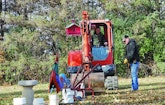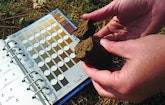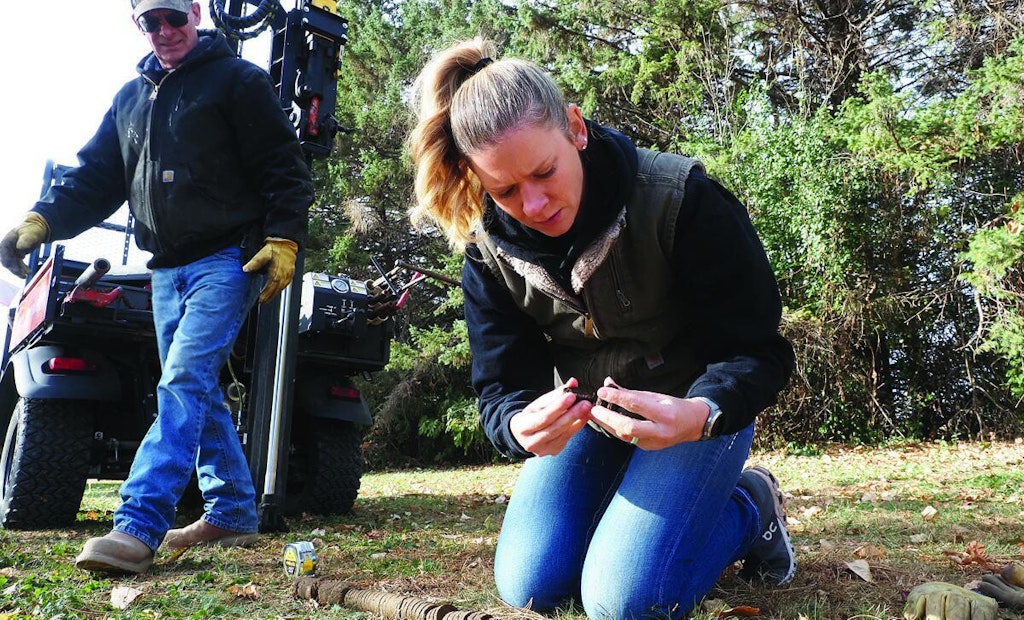
Stacey Feser examines a soil sample. The sample will be important to determining what type of septic system to install on the building site. Her father, Bob Burns, looks on. (Photos by Brad Stauffer)
Interested in Education/Training?
Get Education/Training articles, news and videos right in your inbox! Sign up now.
Education/Training + Get AlertsStacey Feser grew up observing and working in her father’s onsite installation business. One memory from her teenage years stands out.
“He was digging a basement for a house,” she recalls. “I thought it was just crazy that the soil color changed, from dark topsoil to brown subsoil. I didn’t understand why at the time. It sparked an interest.”
Fast-forward a couple of decades and she holds a master’s degree in soil science from the University of Minnesota and operates Feser Environmental (pronounced “Fesser”) in Le Sueur, specializing in onsite system design and compliance inspections.
She works closely with her father, Robert Burns, whose Burns Construction business focuses on system installation. “I do the designs and inspections through my company,” Feser says. “If we get an install, that is run through Burns Construction. We work together. Some days he works for me when we’re doing a design. Some days I work for him when we’re doing an install.”
Both are solo practitioners, working in six counties around their home base in the Minnesota River Valley, about 50 miles south of the Twin Cities.
A CHANGE OF FOCUS
Growing up in Le Sueur, Feser dreamed of becoming an emergency room doctor. After high school she enrolled at St. Catherine University in St. Paul, planning pre-med studies. “For my first biology class, they had a cadaver in the lab that we could go and look at,” she says. “I went in super excited thinking, ‘This is exactly what I came to school for.’
“I got in there and immediately couldn’t handle the smell, couldn’t handle seeing a dead body. And I thought, ‘OK, this path is not for me.’” She stayed at the school for three years, switching to environmental classes and playing on the volleyball team.
For her senior year she transferred to the University of Minnesota, earning a degree in environmental science with a soil science emphasis. She then earned a master’s degree in soil science there with a minor in water quality.
Under a research assistantship she worked at the university’s Southwest Research and Outreach Center in Lamberton, studying controlled drainage and comparing soil characteristics in a never-cultivated native prairie and a farm field with tile drainage installed: “That was my start in the soils profession.”
After college she took a job with Blue Earth County as a septic and wetland regulator. Eight years later, in 2015, she returned to Le Sueur to work with her father, while also launching her own company. “Dad never wanted to get the inspector’s license or some of the advanced licenses for designing larger systems and systems to treat high-strength waste,” Feser says. “He didn’t want to carry that liability on his insurance. That’s why I created my own company.”
LEARNING DESIGN
Feser developed her design expertise in part by observing her father, but mainly through her work with Blue Earth County. “There you’re reviewing all the designs, going out with the different contractors, reviewing their work and seeing how they design systems,” she says.
“There are many ways to choose a site and figure it out. The experience of walking through the process with different people was really helpful and eye-opening. I got a lot of in-depth experience at the county, but with a solid background in understanding the why and where after working with Dad.”
Mound systems are common in southern Minnesota because the soils tend to be finer-textured loams and clay-loams: “We work in areas where glaciers sat for thousands of years and did a good job of compacting our soils. We don’t have the best water movement through those soils.”
A common challenge is fitting systems on small lots around lakes with, on average, about 50 feet of frontage. “Even 100 feet of width sometimes isn’t big enough when you have to figure in parking, garages, boathouses and other features,” Feser says. “If you have hilly topography, that makes it even more challenging.
“Our lakes down here aren’t very deep. You go to northern Minnesota and most of the lakes have nice sandy bottoms and beautiful clearwater. In southern Minnesota we have more mud-bottom lakes, and our clarity isn’t very great. We have a lot of agricultural runoff, which has ignited eutrophication and algae growth in some of our lakes.”
Many property owners are converting small seasonal cabins to lake homes. That means fitting systems on sites never meant to be used for year-round dwellings. Many of the lots have soils that have been cut, filled or moved around. “So in trying to navigate the soil conditions, we’re often taking up basically the entire yard with a system,” Feser says.
MAKING IT WORK
Often the solution to the design challenge includes installing larger pump tanks and then time-dosing the flow to the drainfield: “Then the owners have much better control of water usage, and a much better idea how much water they use. They can say, ‘OK, I can’t use that much because my high-water alarm goes off when I do all my laundry and run the dishwasher all in one day.’
“They learn that they need to spread their water usage out a little bit, check for leaky toilets, and all those things people don’t usually think about but can have an impact on their system.” Electrical panels with event counters and elapsed-time meters from SJE Rhombus can help Feser diagnose and troubleshoot issues related to excessive water usage.
Sometimes aerobic treatment units help solve problems by enabling reductions in drainfield size or the vertical separation between the drainfield and groundwater. That can enable an in-ground system to work instead of a mound. Some counties offer that benefit; others do not.
In any case, ATUs are the exception. “It’s generally not a go-to thing, because the maintenance, monitoring and electrical bills are pretty intense. Those things push people away from that direction,” Feser says. “Restaurants and other applications where we have high-strength waste – that’s where we put them in, because it’s absolutely necessary.”
Feser holds a service provider license that enables her to do the required maintenance on ATUs the company installs (eight such systems to date). She prefers Delta ECOPOD systems (Infiltrator Water Technologies): “I like that one because the maintenance is easy. You can access the whole system from the manhole covers. If there are any issues with blowers, valves or anything like that, it’s handy getting in there to fix things.”
THE TOUGH JOBS
High-strength waste and cluster systems present some of Feser’s toughest yet most satisfying projects. She cites a cluster system for 32 houses on Lake Francis where many of the septic systems were failing. To tackle the job she teamed with installer James Bros. Construction out of Elysian.
“It was the installer who asked me to design the system,” Feser says. “He knew how he wanted to do things. We figured out the best approach for getting all the houses together and having a large enough drainfield area. They ended up purchasing acreage in a farm field to put the drainfield on.
“It was a lot of coordination. It took us about two years to get the system designed, permitted and installed. That also involved the legal paperwork for creating an association and securing all the easements to run the lines. It was a lot more moving parts than I initially thought it would be, but it has been running for five years and has been working really great.” The cluster actually consists of two systems, each designed for just under 5,000 gpd.
Another big project involved a 1,500 gpd system for a golf course with a restaurant and event venue. It used a Nibbler ATU (Aqua Test), well suited for high-strength waste from the kitchen. “The golf course had plenty of space, so we had no problem finding a nice drainfield location,” Feser says. “They specifically liked the at-grade system we installed. A lot of times we hear, ‘I don’t want one of those mounds in my yard.’ The golf course people were very accepting.”
When not designing onsite systems, Feser is often inspecting them, most often for homes at the time of sale. The six counties where Feser Environmental works have different requirements. Some don’t require inspection at property transfer.
“Most of them require it for any type of construction permit,” Feser says. “In the last few years the banks are the ones pushing inspections. They want to see the compliance inspection report, and then they want to see the new system, if necessary, installed before closing. Ninety percent of inspections are for property transfers, and the rest are for new building permits or additions.”
TEACHING TIME
In marketing her business, Feser relies mostly on referrals. “There is an abundance of work, but not many of us who carry the abundance of licenses to be able to do that work,” she says. “I know all the other advanced designers. We talk to each other and share referrals.
“Plus, when I was a regulator in Blue Earth County, I had great relationships with all the contractors. They call and ask me questions, or if they need help on a design, they call me and I work with them. I’m not viewed as a big competitor to their businesses. I’m more like a resource. They can send things my way, and I can send things their way.”
Feser also devotes time from May through October to her 25% position teaching soils classes at her alma mater. She teaches the basic three-day soils class that’s part of the designer license requirement, and also teaches the continuing education soils courses.
As if that’s not enough, she is in her seventh year on the board of the Minnesota Onsite Wastewater Association and became president in early 2022. She values that largely for the networking. “Through teaching I meet a lot of people, but it’s more in passing and I don’t get to establish great relationships with them. Through MOWA board, I’ve been able to get to know people who are on the board and meet people at the annual convention. Being involved through that route has been wonderful.
“The biggest thing I’ve learned is to share knowledge. I try to make property owners feel like I’m here because I really enjoy the industry, and I want to make sure that our environment is safe and healthy for my kids and their grandkids. Pulling together the environmental consequences and the knowledge of wastewater is important.
“Homeowners often don’t understand the connections between a lot of those things. Taking time to walk them through the connections helps with all the steps that come after: the design, the install, and the choices they make when they’re in the house using water.
“The more informed we can make the property owners, the easier it will be for us as installers and designers to maintain systems and keep them working for years and years to come.”
